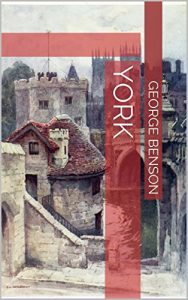As each town has its characteristic features and peculiar advantages, we may ask what it is that constitutes the special attraction exerted by the city of York, not only upon those, who with more or less of appreciation dwell within its limits but upon its visitors. It would seem that if there is one thing which can be done at York better almost than anywhere else in the kingdom, that thing is the realisation of history. It is in this, above all, that the charm lies.
A walled-in city offers great attractions to the student of history, who is desirous of understanding mediaeval ways and methods, for although documents and quaint pictures may give a fair idea, it is the walls, gates, churches, and houses that lend the necessary vividness and reality. Other once-fortified cities have destroyed their walls as being useless, and those at York have from time to time barely escaped destruction.
The stranger, as he walks out of the railway station, is agreeably surprised to find these ancient fortifications immediately presented to his gaze. This surprise view enchants the lover of the picturesque, he is captivated by the beauty of the scene; and York adds another to her numerous admirers. The creamy-grey embattled walls, set on a grassy mound, command attention. The imagination is aroused, the spectator pictures the moat filled with water and mentally recalls the archers, clad in armour and leather jerkins, passing behind the parapet of the elevated walls.
Within the walls, and well seen from the rampart walk, are red-tiled roofs intermingled with more modern slated buildings. Amidst these rise prominently, here and there, the spires and towers of the churches, notably the broad pre-Conquest tower of St. Mary, Bishophill Junior; the tower of St. Michael’s, Ousegate, from which the Curfew is rung nightly, and the graceful octagonal tower of All Saints, Pavement, which, in the days when York was surrounded by forests, held a lamp to direct pilgrims through the pathways to the city.
A walled-in city offers great attractions to the student of history, who is desirous of understanding mediaeval ways and methods, for although documents and quaint pictures may give a fair idea, it is the walls, gates, churches, and houses that lend the necessary vividness and reality. Other once-fortified cities have destroyed their walls as being useless, and those at York have from time to time barely escaped destruction.
The stranger, as he walks out of the railway station, is agreeably surprised to find these ancient fortifications immediately presented to his gaze. This surprise view enchants the lover of the picturesque, he is captivated by the beauty of the scene; and York adds another to her numerous admirers. The creamy-grey embattled walls, set on a grassy mound, command attention. The imagination is aroused, the spectator pictures the moat filled with water and mentally recalls the archers, clad in armour and leather jerkins, passing behind the parapet of the elevated walls.
Within the walls, and well seen from the rampart walk, are red-tiled roofs intermingled with more modern slated buildings. Amidst these rise prominently, here and there, the spires and towers of the churches, notably the broad pre-Conquest tower of St. Mary, Bishophill Junior; the tower of St. Michael’s, Ousegate, from which the Curfew is rung nightly, and the graceful octagonal tower of All Saints, Pavement, which, in the days when York was surrounded by forests, held a lamp to direct pilgrims through the pathways to the city.






